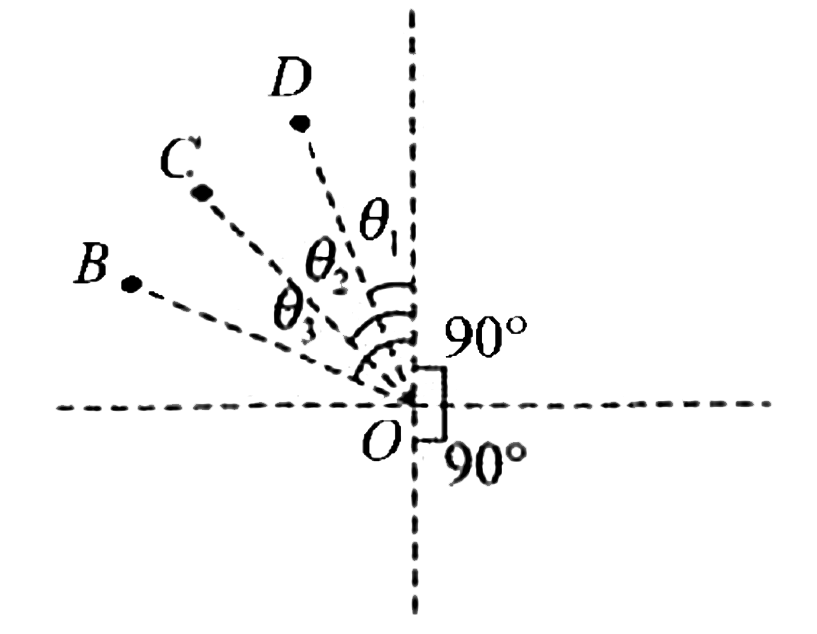For scattering by an .inverse square. field (such as that produced by a charged nucleus in Rutherford.s model), the relation between impact parameter b and the scattering angle θ is given by,
b=Ze2cotθ/24πε0(12mv2)
For a given imapct parameter b, does the angle of deflection increase or decrease with increase in energy ?
To solve the problem, we need to analyze the relationship between the impact parameter b, the scattering angle θ, and the energy of the system. We start with the given equation:
b=Ze2cot(θ/2)4πϵ0(12mv2)
Step 1: Understand the Variables
- b is the impact parameter, which is given and constant.
- Z is the atomic number (a constant for a given nucleus).
- e is the charge of the electron (a constant).
- ϵ0 is the permittivity of free space (a constant).
- m is the mass of the particle (constant).
- v is the velocity of the particle, which is related to its energy.
Step 2: Relate Energy to Velocity
The kinetic energy KE of the particle is given by:
KE=12mv2
If the energy increases, then 12mv2 increases, which implies that v2 must also increase.
Step 3: Substitute Energy into the Equation
Since b is constant, we can rewrite the equation as:
b=Ze2cot(θ/2)4πϵ0KE
Step 4: Analyze the Effect of Increasing Energy
As the energy KE increases, the denominator of the equation increases. Since b is constant, the only way for the equation to hold is if cot(θ/2) decreases.
Step 5: Relate Cotangent to the Angle
If cot(θ/2) decreases, then θ/2 must increase, which means that θ itself must also increase. However, we need to consider the relationship between θ and deflection.
Step 6: Conclusion
Thus, as the energy increases, the angle of deflection θ decreases. This is because a higher energy means the particle is less affected by the nucleus, leading to a smaller deflection angle for a given impact parameter.
Final Answer
For a given impact parameter b, the angle of deflection θ decreases with an increase in energy.
---
- b is the impact parameter, which is given and constant.
- Z is the atomic number (a constant for a given nucleus).
- e is the charge of the electron (a constant).
- ϵ0 is the permittivity of free space (a constant).
- m is the mass of the particle (constant).
- v is the velocity of the particle, which is related to its energy.
The kinetic energy KE of the particle is given by:
Since b is constant, we can rewrite the equation as:
As the energy KE increases, the denominator of the equation increases. Since b is constant, the only way for the equation to hold is if cot(θ/2) decreases.
If cot(θ/2) decreases, then θ/2 must increase, which means that θ itself must also increase. However, we need to consider the relationship between θ and deflection.
Thus, as the energy increases, the angle of deflection θ decreases. This is because a higher energy means the particle is less affected by the nucleus, leading to a smaller deflection angle for a given impact parameter.
For a given impact parameter b, the angle of deflection θ decreases with an increase in energy.
Topper's Solved these Questions
- BOOK - AAKASH SERIESCHAPTER - ATOMSEXERCISE - EXERCISE - I20videos
ATOMS
- BOOK - AAKASH SERIESCHAPTER - ATOMSEXERCISE - EXERCISE - II19videos
ATOMS
- BOOK - AAKASH SERIESCHAPTER - ATOMSEXERCISE - EXERCISE -III25videos
ATOMS
- BOOK - AAKASH SERIESCHAPTER - APPENDICES (REVISION EXERCISE)EXERCISE - LAW OF MOTION128videos
APPENDICES (REVISION EXERCISE)
- BOOK - AAKASH SERIESCHAPTER - CAPACITORS EXERCISE - PRACTICE SHEET (ADVANCED) (Integer Type Questions)2videos
CAPACITORS
Similar Questions
For scattering by an inverse square field (such as that produced by a charged nucleus in Rutherford's model), the relation between impact parameter b and the scattering angle θ is given by,
b=Ze2cotθ/24πε0(12mv2)
What is the impact parameter at which the scattering angle is 90∘ for Z = 79 and initial energy equal to 10MeV ?View SolutionIn Rutherford scattering experiment, wha will be the ratio of impact parameter for scattering angles θ1=90∘andθ2=120∘
View Solution
Knowledge Check
- Question 1 - Select One
For scattering by an inverse-square field (such as that produced by a charged nucleus in Rutherford's model) the relation between impact parameter b and the scattering angle θ is given by, the scattering angle for b=0 is
A180∘B90∘C45∘D120∘
If θ is th angle between the unit vectors a and b , then prove that cos(θ2)=12∣∣→a+→b∣∣,and sin(θ2)=12∣∣→a−→b∣∣
View SolutionFour similar (+q) are placed at origin O, B, C and D as shown. The angles are as shown. Charges at B, C and D are equidistant from O at a distance of a. The forces of repulsion experienced by charge at O due to charges at B and D along CO are equal, given by q2√38πε0a2. Find the relation between θ1,θ2 and θ3:
 View Solution
View SolutionTwo circles with radii aandb touch each other externally such that θ is the angle between the direct common tangents, (a>b≥2) . Then prove that θ=2sin−1(a−ba+b) .
View SolutionTwo circles with radii aandb touch each other externally such that θ is the angle between the direct common tangents, (a>b≥2) . Then prove that θ=2sin−1(a−ba+b) .
View SolutionIf ˆaandˆb are two unit vectors and θ is the angle between them then vector 2ˆb+ˆa is a unit vector if
(A) θ=π3 (B) θ=π6 (C) θ=π2 (D) θ=πView SolutionIf →aand→b are two unit vectors and θ is the angle between them, then the unit vector along the angular bisector of →a and →b will be given by a. →a−→bcos(θ/2) b. →a+→b2cos(θ/2) c. →a−→b2cos(θ/2) d. none of these
View SolutionThe range for a projectile that lands at the same elevation from which it is fired is given by R=(u2/g)sin2θ. Assume that the angle of projection =30∘. If the initial speed of projection is increased by 1%, while the angle of projection is decreased by 2% then the range changes by
View Solution

